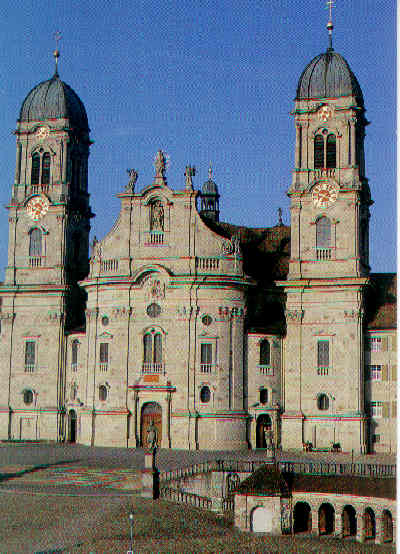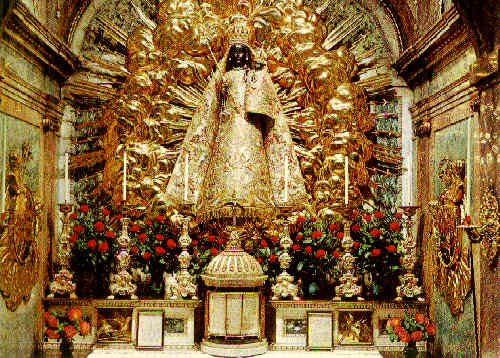Einsiedeln

The History of the Abbey of Einsiedeln
The abby of Eisiedeln dates back to Meinrad the Hermit, a monk from the monastery
of Reichenau, who went to live in solitude around the year 828, whose retreat in
the wilderness formed the nucleus of today's Einsiedeln.
In those days the areas was known as the "Dark Forest". The spot where the Lady Chapel
stands today is where he built his hermit's cell and oratory. It is where he was slain by
two brigands on January 21, 861 after a life of self-denial and prayer.
Two ravens that lived with St. Meinrad pursued the murderers, and in this way, according to legend,
brought their crime to light.
In commemoration of this the abbey of Einsiedeln has since the 13th century borne two ravens in its
coat of arms. St. Meinrad's body was retrieved by the monks from Reichenau and returned to their monastery,
where he was reverently laid to rest.
The site where St. Meinrad lived his life, the secluded cell in the forest, was also revered. Around 910 Benno,
a prebendary of the cathedral of Strasbourg, settled there. In 934 Benno was followed by Eberhard, also from Strasbourg.
It was Eberhard who founded the monastery, to which he summonded the hermits living in the "Dark Forest", and instructed
them in monastic life according to the rule of St. Benedict. Duchess Regenlind of Swabia and, following her examples the Ottonian emperors provided the abby with generous endowments. The young community typified the monastic ideal. This is
attested by the works produced in the abbey's scriptorium.
It was probably in the 13th century that admission to the novitiate in Einsiedeln became restricted to the nobility, and by
the Late Middle Ages the abbey's membership had fallen sharply. As a result, at the beginning of the 16th century the monastery
was headed towards total disintegration. At that point the Schwytzians, the patrons of the abbey, stepped in and turned to Sankt Gallen
for a new abbot. The latter saved the monastery by opening up the novitiate to the commoners.
In the 19th and 20th centuries the monastery's sphere of activities entered a period of marked growth. In 1854 it founded the Archabby of
St. Meinrad in the USA(St. Meinrad, Indiana), and in 1925 worked to establish an agricultural school in Pfaffikon on the Lake of Zurich.
Then in 1948 the abby founded the Priory of Los Toldos in Argentina.
The formerly small abbey school was expanded into a grammer school(US:high school). In 1990 the student body numbered about 390 boys and girls,
133 of the boys were boarders. In 1990 the convent was comprised of 90 fathers and 37 brothers.
The Chapel

The Lady Chapel is considered to be the chapel of St. Meinrad. It was consecrated, probably after being rebuilt, on September 14, 948, by Bishop Konrad
from Constance. According to legend, the chapel was consecrated by Jesus Christ himself. This legend represents a medieval embelishment which had earlier
been applied to other churches, and was then tranferred to the Lady Chapel in Einsedeln.
After the abbey fire of 1465 the interior of the chapel was vaulted, and the corners andside walls between the windows were braced. The front was simply
structured with a three-part arcature above the entrance. A turret with a small bell rose from the roof.
In 1614 Marcus Sitticus, the Archbiship of Salzburg, offered to donate a new facade for the Lady Chapel. Santino Solari, the builder of the Salzburg Cathedral,
served as the architect. The archbishops borther, Count Kasper von Hohenems engaged to have the other three sides faced with marble by Hans Conrad Asper of Constance.
When the french marched into Einsiedeln in May of 1798, they tore down the Lady Chapel. It was rebuilt in a shorter and wider shape from 1816 to 1827 according to
plans by Brother Jakob Natter.
Pilgrimage to Einsiedeln

The pilgrimage of the Madonna of Einsiedeln can be traced back to the first decades of the 14th centurey, by its origin, which are so closely related to the legend
of the Miraculous Consecrations -The "Engelweihe"- maybe be assumed to lie much earlier. A pious legend states that Jesus Christ himself consecrated the Lady Chapel
on the spot where St. Meinrad's hermit's cell once stood, on Septemeber 14, 948.
The original object of pilgrimage was the divinely consecrated chapel itself; later on however, it became a venerated Romanesque Statue of Our Lady, which stood there.
The Feast of the Miraculous Consecration on September 14th is still the most important of the pilrim's festivals through-out the year. The Late Middle Ages witnessed the pilgimage
to Einsiedeln at its peak: the faithful came from as far aways as Northern Germany and the Netherlands.
At the time of the Reformation the number of pilgrims dropped off sharply, but it increased enormously from from the latter half of the 16th century. The Confraternity of the
Rosary used to stage morality plays in Einsiedeln for the annual pilgrimage. After a break of more than 150 years this tradition was reinstated in 1924 with the production of Calderon's
"Great Theatre of the World". The number of pilgrims has shot up radically in recent years
with the advent of the railway and the automobile. Several hundred thousand people now visit Einsiedeln each year, yet it is difficult to say how many of them are pilgrims and how many tourists.
More pictures of the inside
This site hosted by

Get your free home page




![]()